Utah is known by some as the Rock Hounding Capital of the United States! Destinations throughout Central Utah provide the most diverse and unique rock hounding sites in the state. Popular finds include trilobites, gem quality topaz, red beryl, geodes and sun stones. Although rock collecting is permitted on most public lands for personal use, you need to research the area you plan to collect in. Be sure that a permit is not required and check for mining claims. Do not collect on mining claims without the proper permission from the claim owner. Please read the Rules And Regulations Regarding Rock, Mineral, and Fossil Collecting In Utah. Below you will find detailed information on the most popular rocks and fossils collected in Utah.
Trilobite Collecting At U-Dig Fossils
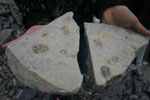 "U-Dig Fossils" provides you with 40 acres of the very best trilobite collecting property in the world. It is located about 52 miles west of Delta, Utah. The most common trilobite fossils found at this location are Elrathia Kingi, Asaphiscus Wheeleri, Peronopsis Interstricta (Agnostus), and the Brachipod. There are less common trilobites to be found as well . The size of trilobite usually found is about an eighth of an inch to 2 inches in length. Just recently a regular to the quarry found a rare trilobite named Olenoides Nevadensis, it is worth well over $2,000.00.
"U-Dig Fossils" provides you with 40 acres of the very best trilobite collecting property in the world. It is located about 52 miles west of Delta, Utah. The most common trilobite fossils found at this location are Elrathia Kingi, Asaphiscus Wheeleri, Peronopsis Interstricta (Agnostus), and the Brachipod. There are less common trilobites to be found as well . The size of trilobite usually found is about an eighth of an inch to 2 inches in length. Just recently a regular to the quarry found a rare trilobite named Olenoides Nevadensis, it is worth well over $2,000.00.
Trilobites and the Cambrian Environment of Utah
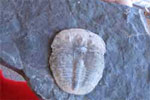 Trilobites. The very name conjures up images from "B" science-fiction movies of bug-eyed, wiggly-legged, insect-like creatures that eat New York. Two questions we commonly receive are "what are trilobites and where are they found in Utah?" Trilobites are members of the phylum Arthropoda (jointed-foot animals). Arthropods have segmented bodies and appendages covered by an exoskeleton which provides support and protection for muscles and organs.
Trilobites. The very name conjures up images from "B" science-fiction movies of bug-eyed, wiggly-legged, insect-like creatures that eat New York. Two questions we commonly receive are "what are trilobites and where are they found in Utah?" Trilobites are members of the phylum Arthropoda (jointed-foot animals). Arthropods have segmented bodies and appendages covered by an exoskeleton which provides support and protection for muscles and organs.
Spanish Fork Canyon Shell Fossils
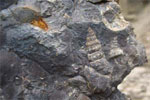 Located approximately 83 miles from Salt Lake City is a location that one can collect ancient shells and clams. The area is loaded with thousands of shells all in one location. This is a great activity for the kids and adults alike. While digging through the shell rock you never know what ancient treasure you will discover. What is even more interesting is knowing that at one point this area was part of a ancient lake. If collecting in the summer be sure to bring lots of water and protection from the sun.
Located approximately 83 miles from Salt Lake City is a location that one can collect ancient shells and clams. The area is loaded with thousands of shells all in one location. This is a great activity for the kids and adults alike. While digging through the shell rock you never know what ancient treasure you will discover. What is even more interesting is knowing that at one point this area was part of a ancient lake. If collecting in the summer be sure to bring lots of water and protection from the sun.
Dugway Geode Beds, Juab County
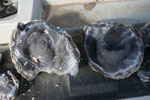 Approximately 6 to 8 million years ago (Miocene epoch), volcanic activity occurred in western Utah and deposited an extrusive igneous rock called rhyolite. Trapped gasses formed cavities within the rhyolite, and millions of years of ground-water circulation allowed minerals to precipitate into the cavities. The result is geodes with spherical shapes and crystal-lined cavities. Roughly 32,000 to 14,000 thousand years ago, a large body of water known as Lake Bonneville covered most of western Utah.
Approximately 6 to 8 million years ago (Miocene epoch), volcanic activity occurred in western Utah and deposited an extrusive igneous rock called rhyolite. Trapped gasses formed cavities within the rhyolite, and millions of years of ground-water circulation allowed minerals to precipitate into the cavities. The result is geodes with spherical shapes and crystal-lined cavities. Roughly 32,000 to 14,000 thousand years ago, a large body of water known as Lake Bonneville covered most of western Utah.
Campout at the Dugway Geode Beds
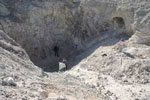 The Dugway Geode Beds not only offers rock hounding opportunities for the beautiful Geodes but the location is great for a weekend campout. There is an abundance of recreational activities such as ATV trails, wildlife viewing, shooting, hiking, and of course rock hounding. The trip to the beds is an adventure in itself as you travel down the historical Pony Express Trail and pass through several historical locations such as the Pet Cemetery and Simpson Springs.
The Dugway Geode Beds not only offers rock hounding opportunities for the beautiful Geodes but the location is great for a weekend campout. There is an abundance of recreational activities such as ATV trails, wildlife viewing, shooting, hiking, and of course rock hounding. The trip to the beds is an adventure in itself as you travel down the historical Pony Express Trail and pass through several historical locations such as the Pet Cemetery and Simpson Springs.
Birdseye Marble
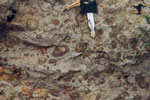 Geologic Information: Approximately 58 to 66 million years ago (Paleocene epoch), a large body of water known as Lake Flagstaff covered parts of northeastern and central Utah. This lake deposited a sequence of sediments that formed rocks known as the Flagstaff Formation. Although these rocks are technically a limestone, the building stone industry has termed this deposit a "marble." The rocks are rich in algal ball structures commonly known as "birdseyes."
Geologic Information: Approximately 58 to 66 million years ago (Paleocene epoch), a large body of water known as Lake Flagstaff covered parts of northeastern and central Utah. This lake deposited a sequence of sediments that formed rocks known as the Flagstaff Formation. Although these rocks are technically a limestone, the building stone industry has termed this deposit a "marble." The rocks are rich in algal ball structures commonly known as "birdseyes."
Bixbyite, Rutile, and Amethyst Crystals
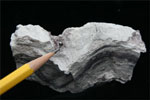 The Marysvale area is dominated by Tertiary igneous rocks ranging from intermediate to silicic compositions with both volcanic and plutonic representatives. The especially thick volcanic section is thought to be the result of a large stratovolcano complex and associated calderas that existed during mid-Tertiary time. One of the common units found near Marysvale is a white to dark gray rhyolite with extremely well-developed flow banding. The crystals, which are found in cavities in the rhyolite, formed in gas pockets that were trapped in the lava flow as it cooled.
The Marysvale area is dominated by Tertiary igneous rocks ranging from intermediate to silicic compositions with both volcanic and plutonic representatives. The especially thick volcanic section is thought to be the result of a large stratovolcano complex and associated calderas that existed during mid-Tertiary time. One of the common units found near Marysvale is a white to dark gray rhyolite with extremely well-developed flow banding. The crystals, which are found in cavities in the rhyolite, formed in gas pockets that were trapped in the lava flow as it cooled.
Topaz Mountain
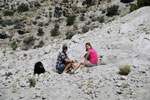 Topaz Mountain is located on the southern end of the Thomas Range. This range is very popular to rock collecting enthusiasts. Topaz, Utah's state gem; is a semiprecious gemstone that occurs as very hard transparent crystals in a variety of colors. The Topaz crystals at Topaz Mountain are naturally amber colored, but become colorless after exposed to sunlight. The crystals formed within cavities of the Topaz Mountain Rhyolit, a volcanic rock which erupted approximately six to seven million years ago (Tertiary Period) from volcanic vents along faults in the area.
Topaz Mountain is located on the southern end of the Thomas Range. This range is very popular to rock collecting enthusiasts. Topaz, Utah's state gem; is a semiprecious gemstone that occurs as very hard transparent crystals in a variety of colors. The Topaz crystals at Topaz Mountain are naturally amber colored, but become colorless after exposed to sunlight. The crystals formed within cavities of the Topaz Mountain Rhyolit, a volcanic rock which erupted approximately six to seven million years ago (Tertiary Period) from volcanic vents along faults in the area.
Obsidian in the Black Rock Desert
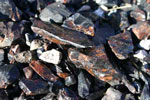 Approximately 2.5 million years ago (late Tertiary Period), volcanic eruptions in the Black Spring area of the Black Rock Desert in western Utah spewed out the volcanic rocks rhyolite, pumice, and obsidian. Obsidian is a dark-colored volcanic glass formed when molten lava cools quickly. It is usually black but colored varieties range from brown to red. Snowflake obsidian, a black obsidian with whitish-gray spots (spherulites) of radiating needle-shaped cristobalite (high-temperature quartz) crystals, is also found in the Black Rock Desert.
Approximately 2.5 million years ago (late Tertiary Period), volcanic eruptions in the Black Spring area of the Black Rock Desert in western Utah spewed out the volcanic rocks rhyolite, pumice, and obsidian. Obsidian is a dark-colored volcanic glass formed when molten lava cools quickly. It is usually black but colored varieties range from brown to red. Snowflake obsidian, a black obsidian with whitish-gray spots (spherulites) of radiating needle-shaped cristobalite (high-temperature quartz) crystals, is also found in the Black Rock Desert.
Rock Hounding For Obsidian - Delta Utah
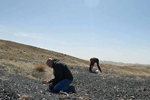 Located approx 43 miles from Delta, Utah via HWY 257 is the Obsidian beds. Obsidian was used by the Native Americans to make arrowheads, spearheads and other tools. This area has a variety of different colors, such as black with white flake patterns called Snowflake Obsidian, and Mahogany Obsidian which is brown or black & brown. There are two different collecting locations with the first having an abundance of the Snowflake and plain black Obsidian.
Located approx 43 miles from Delta, Utah via HWY 257 is the Obsidian beds. Obsidian was used by the Native Americans to make arrowheads, spearheads and other tools. This area has a variety of different colors, such as black with white flake patterns called Snowflake Obsidian, and Mahogany Obsidian which is brown or black & brown. There are two different collecting locations with the first having an abundance of the Snowflake and plain black Obsidian.
Smokey Quartz and Feldspar Crystals
 The Mineral Mountains, located in Beaver County, make up the largest exposed plutonic body in Utah. Rock compositions range from quartz monzonite in the northern half of the pluton to granite around Rock Corral Canyon in the south. Excellent crystals of smoky quartz and feldspar are found in vugs or cavities in the granite. They formed when cooling fractures in the granite were filled by late-stage pegmatites consisting of quartz, microcline, and plagioclase. Quartz occurs as clear to smoky, euhedral crystals up to three inches long while microcline is commonly found as euhedral, equidimensional crystals averaging approximately 0.75 inches in width.
The Mineral Mountains, located in Beaver County, make up the largest exposed plutonic body in Utah. Rock compositions range from quartz monzonite in the northern half of the pluton to granite around Rock Corral Canyon in the south. Excellent crystals of smoky quartz and feldspar are found in vugs or cavities in the granite. They formed when cooling fractures in the granite were filled by late-stage pegmatites consisting of quartz, microcline, and plagioclase. Quartz occurs as clear to smoky, euhedral crystals up to three inches long while microcline is commonly found as euhedral, equidimensional crystals averaging approximately 0.75 inches in width.